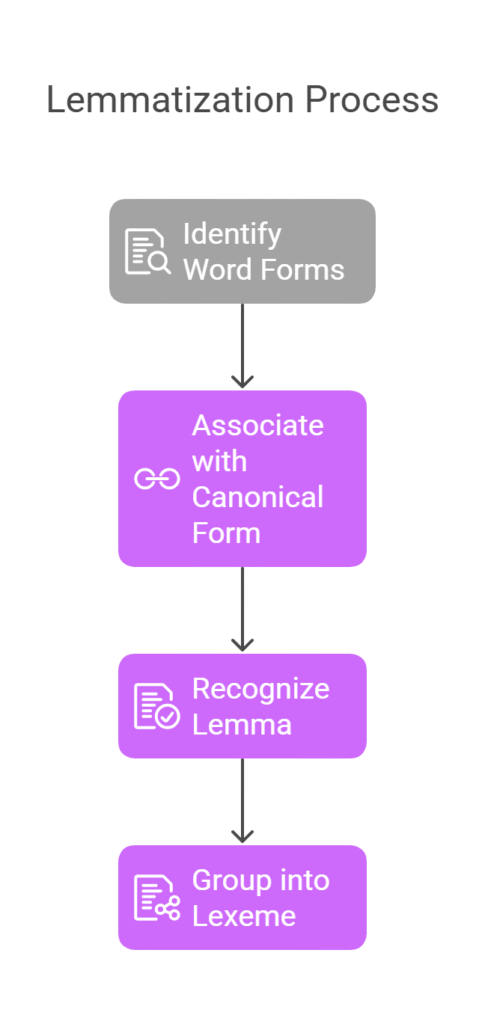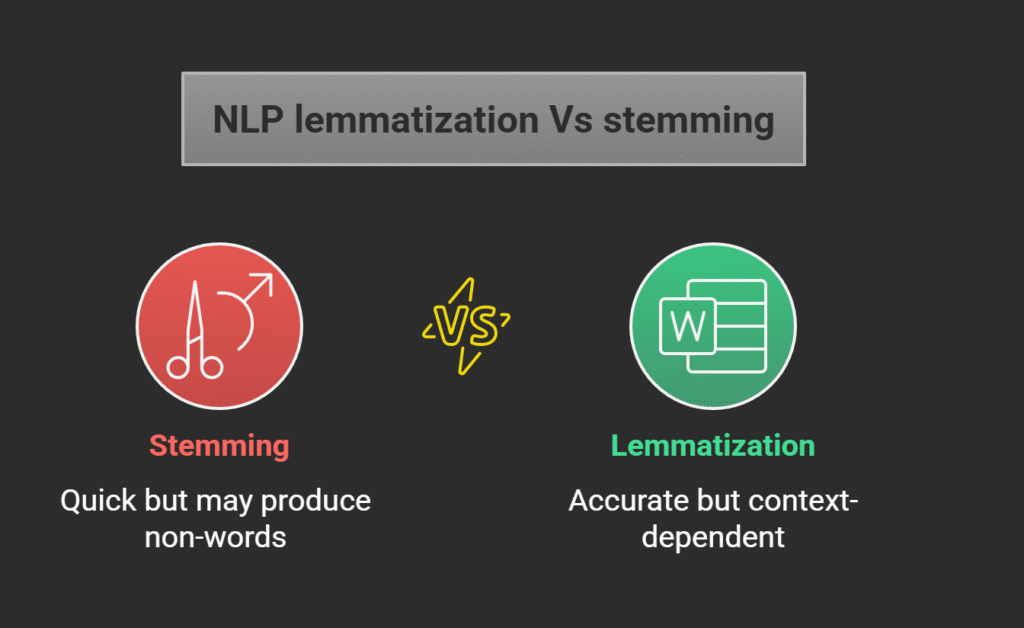This blog discusses lemmatization, including its definition, how it works, applications and purpose, methods, NLP lemmatization vs stemming, and forms of lemmatization, which are explained in depth below.
What is Lemmatization?

Finding that various words have the same root or canonical form despite having varied surface appearances is the goal of the natural language processing work known as lemmatization. It associates a word’s several forms, like “appeared” or “appears,” with its canonical or citation form, commonly referred to as the lexeme or lemma (e.g., “appear”). The form that a word is frequently recognized by, such as its dictionary entry, is called the lemma. A lexeme is a collection of words that reduce to the same lemma.
In order to create a whole English term that makes sense on its own rather than merely a fragment, the main concept is to distil words to their most basic meaning. The verb “sing” has the lemma “sing,” and its forms “sang,” “sung,” and “sings” are variations. Also, “mouse” is the lemma for “mice,” and “am,” “are,” and “is” share “be.”
How Lemmatization Works

Complete morphological parsing of the word is required for the most advanced lemmatization techniques. The study of morphology examines how words are constructed from morphemes, which are smaller units of meaning. Lexical analysis looks at how words are given structure in a language.
Purpose and Lemmatization Applications
Relating morphological variations to their base form is the main goal of lemmatization. This procedure is essential for a number of NLP tasks:
- Information Retrieval (IR): To increase search accuracy in applications such as searching, it makes sense to group morphological variations under a single lemma. Finding instances of any of a word’s morphological variations when a user searches for it fulfils the semantic criterion of the search. Texts can be searched using a lemma list to lemmatization.
- Grouping Words: For indexing purposes, words with the same root (lemma) are treated as referring to the same notion or concept. This allows for the grouping of various inflected variants of a word.
Lexical Analysis: Using a lemma dictionary to relate word strings to their lemma is a fundamental task in lexical analysis. Semantic and syntactic information in this lemma dictionary is invariant.
- Machine Translation (MT): The lemma dictionary provides access to the lexical semantics of word strings. Lemmatization aids in producing the morphosyntactic representation of strings for syntactic analysis in transfer models.
Approaches
Several approaches are used:
For many languages, morphological analyzers and lemma lexicons are standard tools. Inflected forms can be mapped to their common lemma using a morphological analyzer. The base form is found by consulting a lemma dictionary (lexicon).
- Finite State Transducers (FSTs): FSTs are capable of handling the mapping between a word string and its lemma, as well as the morphosyntactic properties that go along with it, in an elegant manner. Morphologically complicated forms can be parsed into their underlying representations by them. FSTs are able to encode morpheme ordering, which is crucial for accurate mapping, as well as the morphotactic combination of stems and affixes. The Item and Arrangement (I&A) method to morphology is characterized by this.
- The Word and Paradigm (W&P) Approach is an alternate approach that relates a morphological variation to its collection of morphosyntactic features by associating a lemma with a table (paradigm).
- Context and Part of Speech (POS): Taking into account the context of a word improves lemmatization accuracy. Lemmatization frequently requires identifying a word’s part of speech (POS), which aids in determining the appropriate dictionary form. A preprocessing operation called POS tagging may involve parsing strings into morphosyntactic categories and subcategories.
- Dictionary Checking: Affixes are only removed by certain lemmatizes, such as WordNet lemmatize, if the resultant word appears in their dictionary.
Also, Read About What Is Language Detection In Natural Language Processing
NLP lemmatization Vs stemming

Stemming
- Stemming, a coarser method also used for morphological normalization, is sometimes contrasted with lemmatization. Important distinctions include:
- Output: Stemming uses heuristics to remove affixes, and the stem that results could not be a word. The words “pictures” and “pictured,” for example, may be stemmed to “pictur.” Conversely, lemmatisation produces a whole English word that makes meaning by itself. Words are changed to their lemma.
Lemmatization
- Lemmatization is a linguistic procedure that usually entails utilising morphological analysis or searching up words in a lexicon. Simpler rule-based techniques are frequently used in stemming to simply strip endings.
- Accuracy/Scope: Lemmatization is usually more accurate, particularly when dealing with words that are unclear or that need context to be correctly lemmatized. It is capable of handling changes such as “geese” to “goose.” Lemmatization produces “leaf,” but stemming may not handle irregular forms or cases like “leaves” stemming to “leav.” Lemmatization seeks to understand forms compositionally, whereas stemming seeks to relate forms.
- Lemmatization offers a more precise and linguistically sound base form, even though stemming is easier and more computationally efficient, particularly for IR. Both procedures are particular to a certain language.
- Lemmatization functions are provided by libraries such as TextBlob and NLTK.
Lemmatization types
One of three forms of lemmatization is employed, depending on the methodology and the language characteristics being addressed.
Also, Read About Grammar Correction NLP & What Is Question Answering In NLP
Rule-based lemmatization
This method determines a word’s base form using explicit linguistic rules. It applies grammatical principles pertinent to various portions of speech and looks at word structure. By doing this, it determines the proper base form according to the context of the word. This approach works especially effectively for languages with clear grammatical structures.
Dictionary-based lemmatization
The lemmatizer can look up each word and determine its base form by using an existing dictionary or lexicon that maps words to their lemmas. For instance, the dictionary may have the following entries:
- “running” → “run”
- “better” → “good”
- “geese” → “goose”
This method has the benefit of being able to deal with exceptions and irregular words as long as they are listed in the dictionary.
Machine learning-based lemmatization
To comprehend the connections between words and their fundamental forms, this approach makes use of machine learning (ML) models that have been trained on massive text collections. Even if the new words aren’t found in a dictionary, these models are able to identify patterns and apply what they have learnt to them. A model might be taught, for instance, that words that end in ly are frequently adverbs and ought to be lemmatized to their base adjective form.
